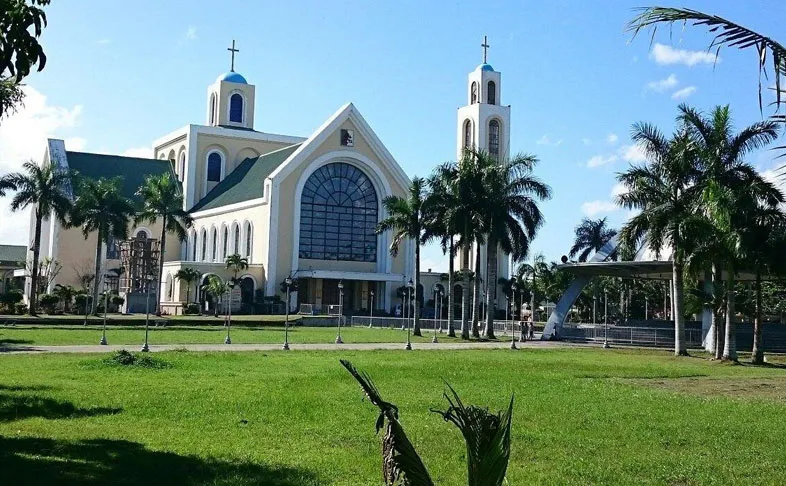
Introduction
The Minor Basilica and National Shrine of Our Lady of Peñafrancia (Spanish: Basílica Menor y Santuario Nacional de Nuestra Señora de Peñafrancia) also known as the Peñafrancia Basilica, stands as a Roman Catholic minor basilica situated on the outskirts of Naga City. It is also recognized as the “Pilgrim City” and “Queen City of Bicol” in the Bicol Region of the Philippines.
This sanctuary holds the distinction of being one of the largest Marian pilgrimage sites in Asia. The icon of Our Lady of Peñafrancia finds its sacred abode within this hallowed place. Remarkably, it serves as the sole basilica within the Bicol Region and the Roman Catholic Archdiocese of Caceres.
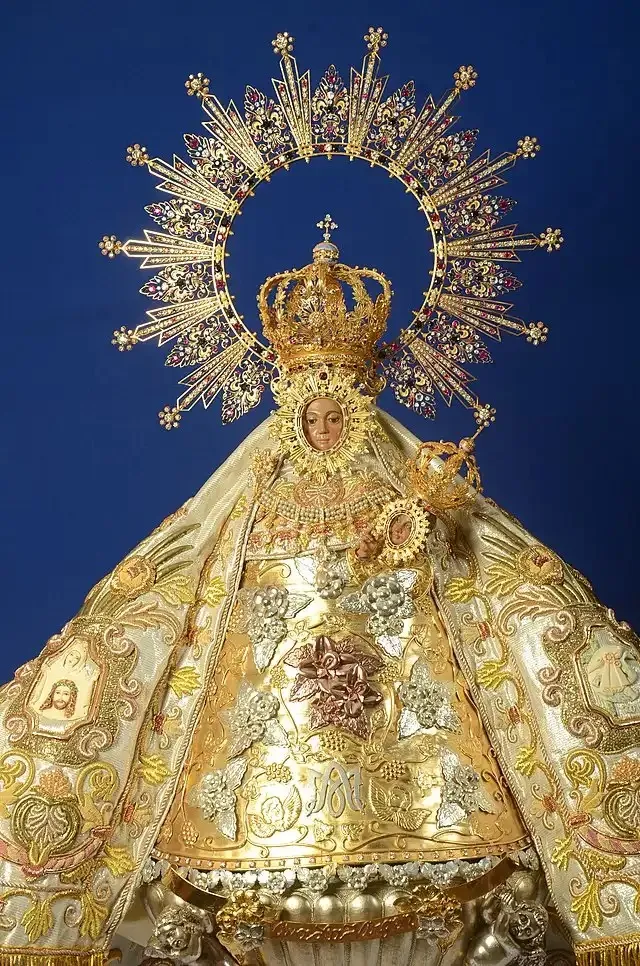
Our Lady of Penafrancia has her roots in Spain, specifically in the sanctuary of Nuestra Señora de la Peña de Francia. This sacred place became a symbol of hope and miracles, drawing countless faithful followers who sought solace and divine intervention.
On May 19, 1434, Simón Vela, after removing a huge rock in the mountains of Peña de Francia, found an image of the Blessed Mother carrying on her arms, the child Jesus. It was hidden together with other images and church bells to prevent them from falling into the hands of Moors/Saracens who were invading the south of Spain in the 12th Century.
The wooden image depicts a crowned Madonna and Child, with the infant Jesus looking toward his mother. The image stands on a silver base and is covered with a silver frontal and a voluminous cloak. A rostrillo (an oval frame of rays) surrounds the face of both the Virgin and the Child (Gorospe and Javellana 1995, 20).
The title “Peñafrancia” came from the place Peña de Francia, meaning Rock of France. A Frenchman named Simon Vela was believed to have been sent by a prophetic voice to a rocky mountaintop in Salamanca, Spain, to unearth an image of the Virgin Mary, later known as Peñafrancia. The image is known to devotees by the title Ina, a local term for “Mother”.
In the 17th century, a devout man named Miguel Robles de Covarrubias brought a painting of Our Lady of Penafrancia to the Philippines. A Spanish colonial official from Peñafrancia, Spain (a native of San Martín de Castañeda) settled with his family in Cavite in 1712. One day, Miguel Robles de Covarrubias, a son of the official and a seminarian studying at the Universidad de Santo Tomás in Manila, fell seriously ill.
He and his family prayed to Our Lady of Peñafrancia, whose picture Miguel clutched to his breast as he hoped for recovery. Miguel vowed that if cured, he would out of gratitude construct a chapel on the banks of the Pasig River in Manila.
Miguel was miraculously cured, and ordained a priest not in Manila but in Ciudad de Nueva Cáceres (now Naga City) by Bishop Andrés González. To fulfill his vow, Miguel (who was the first diocesan priest ordained in Naga), did two things.
First, he mobilised natives along the slopes of Mount Isarog to build a chapel from the local nipa and bamboo, at a site by the banks of the Bikol River and not the Pasig as he earlier desired. Second, he ordered a local artisan to carve an image patterned after the picture of Our Lady of Peñafrancia that he always carried with him.
Stories of miracles surrounding the image began circulating immediately, beginning with the account of a resurrected dog. The animal was killed for its blood, which was to be used in painting the newly carved image of Our Lady, and the carcass was dumped into the Bikol river. The dog suddenly came back to life and began swimming; hundreds allegedly witnessed the event.
News of many other miracles spread quickly, as did public devotion to the image. A letter sent by Miguel to the Dominicans in Salamanca, Spain in 1712 reported numerous miracles through the intercession of Our Lady. The number of devotees eventually increased beyond the Diocese of Nueva Cáceres, which comprised the Bicolandia and Marinduque, and in modern times the devotion has reached other parts of the world along with the Filipino diaspora.
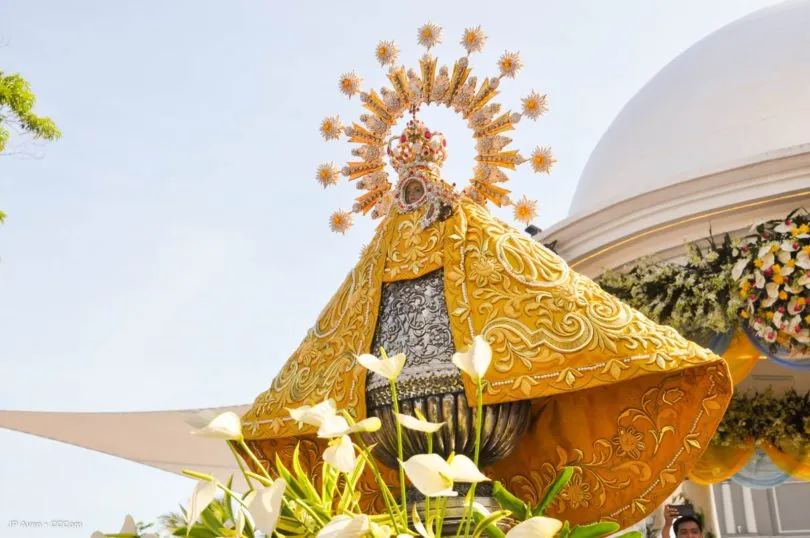
Around the year 1710, Rev. Fr. Miguel Robles de Covarrubias, upon the petition of the Cimarrones, built a Chapel and from a stampita he always had with him, had a replica of the Lady of Peña de Francia carved from wood then enshrined her at the said Chapel. Immediately, people came to visit, most especially, during the Saturday Novena and Mass at the Chapel.
After a while, Fr. Miguel returned to Manila. But when his left eye became totally blind, he pledged to the Lady that he will return to Nueva Caceres and build the stone church he promised her. After returning to Naga, he initiated the building of the stone church. In 1741, it was not known if Fr. Miguel was still alive or already dead by then, under Most Rev. Ysidro de Arevalo, DD, the stone church was erected.
The present shrine was built by Bishop Ysidro Arevalo in 1741 and renovated by Francisco Gainza during the late 19th century to accommodate the growing number of devotees. As the devotion grew even more, a larger church was built on the other side of the river to house the image. This church was elevated to the rank of a minor basilica in 1985 (Gorospe and Javellana 1995, 18-19, 24-25, 82).
Renovation of the Basillica
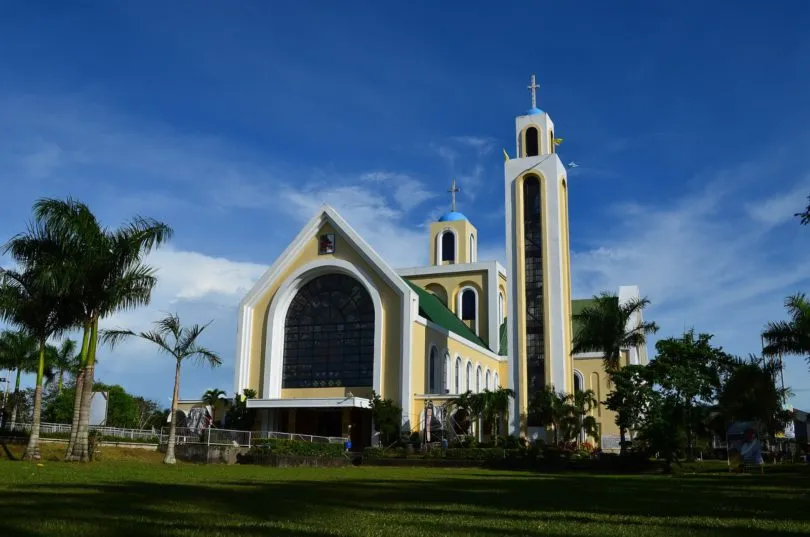
Archbishop Pedro P. Santos noted that the devotees and pilgrims kept increasing through the years. In 1960, he dreamt of building a basilica to honor the Virgin. Shortly after, through the meditation of the Archbishop Emeritus Teopisto V. Alberto, D.D. and the Association of Our Lady of Peñafrancia, Mr and Mrs Macario Mariano donated a three-hectare lot in Barrio Balatas.
Bishop Concordio Sarte initiated the groundwork for the construction, with the blessing rite and laying of the cornerstone held on Easter Sunday, April 18, 1976. Dignitaries included those of the Philippine Catholic Church led by Cardinal Jaime Sin, the Archbishop of Manila, as well as prominent Bicolano sponsors.
Construction began on April 18, 1976, but was delayed for a number of years due to financing problems and was not completed until September 1981. Fr. Sofio Balce reorganized the different committees and launched “Operation Peñafrancia Basilica”. From then on, construction continued on at an almost fevered pitch until it was finally completed in September 1981.
On May 22, 1982, it was initially dedicated as the Church of Nuestra Señora de Peña de Francia. Exactly three years later, the church was given the title of “Basilica Minore” by the Holy See after a request from the third Archbishop of Cáceres, Leonardo Z. Legaspi, O.P., D.D.
In 1991, the basilica Rector, Msgr. Manolo de los Santos, began repairs on the basilica. The doors were reinforced and strengthened, stained glass windows and oil paintings of the Stations of the Cross were installed, while concrete pathways and drainage systems were constructed around the shrine complex. His efforts, however, were cut short in late June 1993 due to his transfer to Iriga City as its new parish priest.
In July 1993, the new Rector, Msgr. Alberto Nero, resumed major repairs and repainting of the structure. The first move was to treat the entire church and shrine complex with anti-termite chemicals to control and exterminate the pests, which have already damaged portions of the building.
By September 1994, the leaking roofs of the basilica were fully repaired and repainted, with the damaged ceiling rehabilitated and repainted together with the interior walls. The electrical wirings and installations were also retrofitted, while the giant chandeliers were replaced with the more luminous and economical Highbay luminaire lamps. The cross topping the dome was fitted with neon light tubes to distinguish the basilica at night from afar, and a 20 KVA standby power generator was installed to supply the emergency light system during outages.
On November 3, 1994, the repair works and repainting of the exterior walls were resumed. The broken window panes, and partly corroded steel window frames were replaced and strengthened. The towering belfry, however, remained untouched.
Architecture Of The Basilica Of Our Lady of Penafrancia
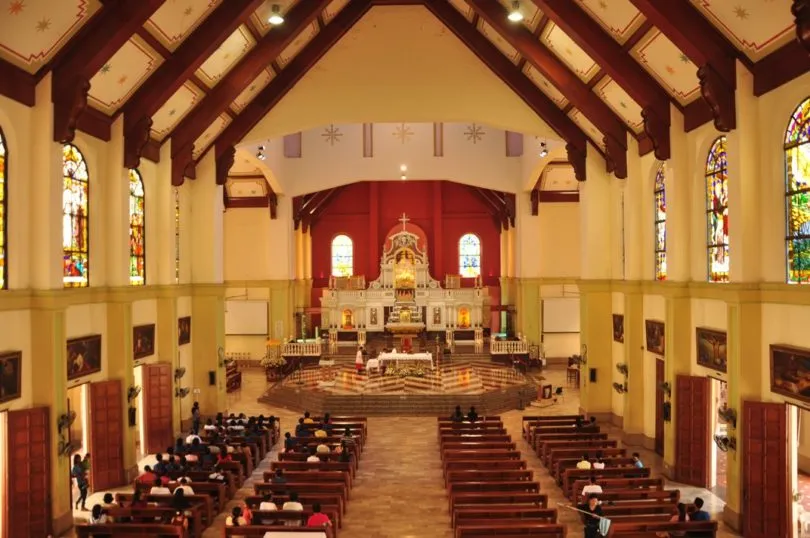
The Stone Church of Our Lady of Penafrancia stands tall and majestic, a symbol of both history and architectural prowess. It was Bishop Isidro Arevalo who took the lead in building this magnificent structure around the year 1750
The design of the stone church is a fusion of various architectural styles, showcasing a harmonious blend of Baroque and Renaissance elements. The use of locally sourced stones, meticulously crafted and arranged, adds to the church’s unique charm and character.
The church features a striking façade adorned with intricate carvings, depicting scenes from the life of the Virgin Mary and the religious history of the region. The attention to detail is evident in every nook and cranny, showcasing the skill and craftsmanship of the artisans involved in its construction.
Upon entering the stone church, one is immediately greeted by a sense of tranquility and reverence. The interior is a visual feast for the eyes, with soaring arches, ornate altars, and vibrant stained glass windows that bathe the space in a divine light. The high vaulted ceiling adds to the sense of awe, inviting visitors to look up and contemplate the wonders of faith.
The stone church also houses various religious artifacts and relics, including statues, paintings, and religious relics that hold great significance to the faithful. These treasures serve as tangible reminders of the miracles and blessings that have been associated with Our Lady of Penafrancia over the centuries.
The architecture of The Stone Church of Our Lady of Penafrancia is a remarkable display of both historical significance and architectural mastery. Built around the year 1750 under the leadership of Bishop Isidro Arevalo, this majestic structure stands tall as a symbol of the region’s rich heritage.
The western side of the church bears engraved coat of arms of Bishop Arevalo, serving as concrete evidence of his involvement in the construction of this magnificent edifice. This architectural marvel showcases intricate craftsmanship and attention to detail, leaving a lasting impression on all who witness its grandeur.
Notably, the church’s façade holds a special place in its architectural beauty. According to legend, the Chinese community in the area generously donated the façade as a testament to their unwavering devotion to the Virgin Mary. The façade itself is a true masterpiece, showcasing the artistry of Chinese culture. The surface is adorned with exquisitely engraved pots, plates, jars, and various other intricate designs, exemplifying the dedication and artistic prowess of the Chinese community.
Beyond its architectural splendor, The Stone Church of Our Lady of Penafrancia is deeply intertwined with miracles and faith. As the beloved patroness of the Bicol region, Our Lady of Penafrancia attracts countless devotees seeking solace and redemption. The church serves as a gathering place for the vibrant Catholic community in the area, fostering a sense of unity and devotion.
The church’s historical and cultural significance, coupled with its remarkable architecture, make it a prominent destination for visitors exploring the Bicolandia region. Whether one seeks to appreciate the intricate details of the façade or delve into the rich history and miracles associated with the church, The Stone Church of Our Lady of Penafrancia offers a truly captivating experience.
The architecture of the Penafrancia Church in Naga City, Philippines is a testament to the rich history and religious significance of the Penafrancia Festival. The church, officially known as the Basilica Minore de Nuestra Señora de Peñafrancia, is a stunning example of Spanish colonial architecture.
The church is characterized by its grandeur and beauty. Its facade features intricate carvings and ornate designs, showcasing the craftsmanship of the past. The entrance is adorned with statues and reliefs depicting scenes from the life of the Virgin Mary, inviting visitors to enter and experience the spiritual atmosphere within.
Inside the church, the soaring ceilings, grand arches, and beautiful stained glass windows create a sense of awe and reverence. The altar, adorned with gold leaf and ornate decorations, is the focal point of the church. It houses the sacred image of Our Lady of Penafrancia, surrounded by candles and flowers as offerings from devotees.
The architecture of the Penafrancia Church reflects the fusion of Filipino and Spanish influences. The use of local materials, such as adobe stone, adds a touch of authenticity to the structure. The combination of Spanish colonial elements, such as the baroque style, and indigenous design elements creates a unique architectural identity that is distinctly Filipino.
Beyond its aesthetic beauty, the architecture of the Penafrancia Church serves a larger purpose. It provides a sacred space for devotees to express their faith, seek solace, and offer prayers. The design of the church allows for a sense of tranquility and solemnity, creating a conducive environment for worship and reflection.
The architecture of the Penafrancia Church is a visual manifestation of the deep devotion and reverence of the Filipino people towards Our Lady of Penafrancia. It combines Spanish colonial and indigenous design elements to create a structure that is not only aesthetically pleasing but also spiritually significant. The church stands as a symbol of faith, unity, and cultural heritage, inviting visitors to experience the divine presence of Our Lady of Penafrancia.
The Chinese community in the locality generously donated the façade, demonstrating their unwavering devotion to the Virgin. The façade was a testament to Chinese art, with pots, plates, jars, and whatnot engraved on it.
Feast Day
The Feast Of Our Lady of Penafrancia is celebrated on the third weekend of September and many pilgrims travel to Naga. This one week celebration begins on the second Friday of September with a procession called Traslacion. This procession is the transferring of the image of Our Lady of Penafrancia from the Basillica to the Naga Cathedral for a Novena and celebration of holy masses leading into the third weekend of September. On this last day of the Novena, her image is transferred back to the Basillica in a procession via a boat along the Bicol River. Many candles, colors and flowers are seen during the procession and pilgrims will say with great lov for Ina, “Viva La Virgen!”(Long Live The Virgin!).
- September 8, 2023 (Friday) – Traslacion Procession
- September 16, 2023 (Saturday) – Fluvial Procession
- September 17, 2023 (Sunday) – Feast Day of Our Lady of Peñafrancia
Mass Timing
Week days
- 06.00 am – 07.00 am (Bikol)
- 07.00am – 08.00am (English)
- 11.00am – 12.00pm (English)
- 12.15pm – 01.15 pm (English, Cripta)
- 05.15pm – 06.15pm (English)
Saturday
- 06.00 am – 07.00 am (Bikol)
- 07.00am – 08.00am (English)
- 11.00am – 12.00pm (English)
- 12.15pm – 01.15 pm (English, Cripta)
- 04.00pm – 05.00pm (Bikol, anticipated mass)
- 05.15pm – 06.15pm (English, anticipated mass)
Sunday
- 06.00 am – 07.00 am (Bikol)
- 08.00 am – 09.00 am (Bikol)
- 10.00am – 11.00pm (English)
- 12.00am – 01.00pm (Tagalog)
- 04.00pm – 05.00pm (Bikol)
- 06.00 pm – 07.00 pm (English)
Contact Info
J5JX+RXH, Balatas Rd, Naga,
4400 Camarines Sur, Philippines
Phone No.
Phone: +63 54 473 3644
Accommodations
How to reach the Sanctuary
Airway
The nearest airport to the Basilica of Our Lady of Penafrancia is Naga City Airport (WPN) in Pili town which is just ten kilometres from the Basillica.
Railway
The nearest rail station to the Basilica of Our Lady of Penafrancia is Naga Railway Station which is just two kilometres from the Basillica.







